Effects of Soil Properties and Tree Species on Root–Soil Anchorage Characteristics
Abstract
1. Introduction
2. Materials and Methods
2.1. Study Area
2.2. Soil and Root Collection
2.3. Test Methods
3. Soil and Root Properties
3.1. Soil Physical Properties
3.2. Root Traits of Five Tree Species
3.3. Root Tensile Resistance of Five Tree Species
4. Results and Discussion
4.1. Root Pullout Test Pullout Load–Slippage Curves
4.2. Failure Mode of the Roots
4.3. Effect of Soil Water Content on Anchoring Action
4.4. Effect of Soil Dry Weight on Anchorage Action
4.5. Effect of Root Species on Anchoring Action
5. Conclusions
- (1)
- The maximum pullout force of the root system increased with increasing root diameter and tensile strength. The peak sliding decreases with the increase of root system diameter.
- (2)
- As the soil water content increases, the root system is more susceptible to breakage failure. An optimum soil water content exists that allows for the best anchoring of the root system roots. Soil water content has no significant effect on peak sliding.
- (3)
- Root systems are more susceptible to breakage failure as the dry weight of the soil increases. The maximum tension of the root system decreases with decreasing soil dry weight. As the soil dry weight decreased, the root displacement also decreased.
- (4)
- In the root pullout test of five species, the root system of Larix gmelinii was the most susceptible to breakage failure, while the root system of Pinus tabulaeformis was the least susceptible to breakage. The root system of Pinus tabulaeformis was the least effective in anchoring the soil, while the root system of Betula platyphylla was the most effective in anchoring.
Author Contributions
Funding
Institutional Review Board Statement
Informed Consent Statement
Data Availability Statement
Acknowledgments
Conflicts of Interest
References
- Commandeur, P.R.; Pyles, M.R. Modulus of elasticity and tensile strength of Douglas-fir roots. Can. J. For. Res. 1991, 21, 48–52. [Google Scholar] [CrossRef]
- Ennos, A.R.; Fitter, A.H. Comparative functional morphology of the anchorage systems of annual dicots. Funct. Ecol. 1992, 6, 71–78. [Google Scholar] [CrossRef]
- Mickovski, S.B.; Ennos, R.A. A morphological and mechanical study of the root systems of suppressed crown Scots pine Pinus sylvestris. Trees 2002, 16, 274–280. [Google Scholar] [CrossRef]
- Sun, H.; Li, S.; Xiong, W.; Yang, Z.; Cui, B.; Yang, T. Influence of slope on root system anchorage of Pinus yunnanensis. Ecol. Eng. 2008, 32, 60–67. [Google Scholar] [CrossRef]
- Wang, X.; Hong, M.; Huang, Z.; Zhao, Y.; Ou, Y.; Jia, H.; Li, J. Biomechanical properties of plant root systems and their ability to stabilize slopes in geohazard-prone regions. Soil Till. Res. 2019, 189, 148–157. [Google Scholar] [CrossRef]
- Zhang, C.; Li, D.; Jiang, J.; Zhou, X.; Niu, X.; Wei, Y.; Ma, J. Evaluating the potential slope plants using new method for soil reinforcement program. Catena 2019, 180, 346–354. [Google Scholar] [CrossRef]
- Yang, M.; Défossez, P.; Danjon, F.; Dupont, S.; Fourcaud, T. Which root architectural elements contribute the best to anchorage of Pinus species? Insights from in silico experiments. Plant Soil 2017, 411, 275–291. [Google Scholar] [CrossRef]
- Crook, M.J.; Ennos, A.R. The anchorage mechanics of deep rooted larch, Larix europea × L. Japonica. J. Exp. Bot. 1996, 47, 1509–1517. [Google Scholar] [CrossRef]
- Zhou, Y.; Watts, D.; Li, Y.; Cheng, X. A case study of effect of lateral roots of Pinus yunnanensis on shallow soil reinforcement. For. Ecol. Manag. 1998, 103, 107–120. [Google Scholar] [CrossRef]
- Goodman, A.M.; Crook, M.J.; Ennos, A.R. Anchorage Mechanics of the Tap Root System of Winter-sown Oilseed Rape (Brassica napus L.). Ann. Bot. -Lond. 2001, 87, 397–404. [Google Scholar] [CrossRef]
- Burylo, M.; Rey, F.; Roumet, C.; Buisson, E.; Dutoit, T. Linking plant morphological traits to uprooting resistance in eroded marly lands (Southern Alps, France). Plant Soil 2009, 324, 31–42. [Google Scholar] [CrossRef]
- Schwarz, M.; Cohen, D.; Or, D. Root-soil mechanical interactions during pullout and failure of root bundles. J. Geophys. Res. 2010, 115, F04035. [Google Scholar] [CrossRef]
- Mickovski, S.B.; Ennos, A.R. Anchorage and asymmetry in the root system of Pinus peuce. Silva Fenn. 2003, 37, 161–173. [Google Scholar] [CrossRef][Green Version]
- Tanaka, N.; Samarakoon, M.B.; Yagisawa, J. Effects of root architecture, physical tree characteristics, and soil shear strength on maximum resistive bending moment for overturning Salix babylonica and Juglans ailanthifolia. Landsc. Ecol. Eng. 2011, 8, 69–79. [Google Scholar] [CrossRef]
- Fourcaud, T.; Ji, J.N.; Zhang, Z.Q.; Stokes, A. Understanding the impact of root morphology on overturning mechanisms: A modelling approach. Ann. Bot. 2008, 101, 1267–1280. [Google Scholar] [CrossRef]
- Cucchi, V.R.; Meredieu, C.L.; Stokes, A.; Berthier, S.P.; Bert, D.; Najar, M.; Denis, A.; Lastennet, R. Root anchorage of inner and edge trees in stands of Maritime pine (Pinus pinaster Ait.) growing in different podzolic soil conditions. Trees 2004, 18, 460–466. [Google Scholar] [CrossRef]
- Genet, M.; Stokes, A.; Salin, F.; Mickovski, S.B.; Fourcaud, T.; Dumail, J.; van Beek, R. The influence of cellulose content on tensile strength in tree roots. Plant Soil 2005, 278, 1–9. [Google Scholar] [CrossRef]
- Schwarz, M.; Cohen, D.; Or, D. Pullout tests of root analogs and natural root bundles in soil; Experiments and modeling. J. Geophys. Res. 2011, 116, F02007. [Google Scholar] [CrossRef]
- Li, Y.; Wang, Y.; Ma, C.; Zhang, H.; Wang, Y.; Song, S.; Zhu, J. Influence of the spatial layout of plant roots on slope stability. Ecol. Eng. 2016, 91, 477–486. [Google Scholar] [CrossRef]
- Ennos, A.R. The mechanics of anchorage in seedlings of sunflower, Helianthus annuus L. New Phytol. 1989, 113, 185–192. [Google Scholar] [CrossRef]
- Bailey, P.H.; Currey, J.D.; Fitter, A.H. The role of root system architecture and root hairs in promoting anchorage against uprooting forces in Allium cepa and root mutants of Arabidopsis thaliana. J. Exp. Bot. 2002, 53, 333–340. [Google Scholar] [CrossRef]
- Mickovski, S.B.; van Beek, L.P.H.; Salin, F. Uprooting of vetiver uprooting resistance of vetiver grass (Vetiveria zizanioides). Plant Soil 2005, 278, 33–41. [Google Scholar] [CrossRef]
- Rahardjo, H.; Harnas, F.R.; Indrawan, I.G.B.; Leong, E.C.; Tan, P.Y.; Fong, Y.K.; Ow, L.F. Understanding the stability of Samanea saman trees through tree pulling, analytical calculations and numerical models. Urban For. Urban Green. 2014, 13, 355–364. [Google Scholar] [CrossRef]
- Zhang, C.; Liu, Y.; Li, D.; Jiang, J. Influence of soil moisture content on pullout properties of Hippophae rhamnoides Linn. Roots. J. Mt. Sci. -Engl. 2020, 17, 2816. [Google Scholar] [CrossRef]
- Fan, C.; Lu, J.Z.; Chen, H.H. The pullout resistance of plant roots in the field at different soil water conditions and root geometries. Catena 2021, 207, 105593. [Google Scholar] [CrossRef]
- Boldrin, D.; Leung, A.K.; Bengough, A.G. Effects of root dehydration on biomechanical properties of woody roots of Ulex europaeus. Plant Soil 2018, 431, 347–369. [Google Scholar] [CrossRef]
- Jotisankasa, A.; Taworn, D. Direct shear testing of clayey sand reinforced with live stake. Geotech. Test. J. 2016, 39, 608–623. [Google Scholar] [CrossRef]
- Fan, C.; Su, C. Role of roots in the shear strength of root-reinforced soils with high moisture content. Ecol. Eng. 2008, 33, 157–166. [Google Scholar] [CrossRef]
- Mahannopkul, K.; Jotisankasa, A. Influences of root concentration and suction on Chrysopogon zizanioides reinforcement of soil. Soils Found. 2019, 59, 500–516. [Google Scholar] [CrossRef]
- Nicoll, B.C.; Gardiner, B.A.; Rayner, B.; Peace, A.J. Anchorage of coniferous trees in relation to species, soil type, and rooting depth. Can. J. For. Res. 2006, 36, 1871–1883. [Google Scholar] [CrossRef]
- Dupuy, L.; Fourcaud, T.; Stokes, A. A numerical investigation into the influence of soil type and root architecture on tree anchorage. Plant Soil 2005, 278, 119–134. [Google Scholar] [CrossRef]
- Ennos, A.R. The anchorage of leek seedlings: The effect of root length and soil strength. Ann. Bot.-Lond. 1990, 65, 409–416. [Google Scholar] [CrossRef]
- Zhang, X.; Hu, X.; Li, G.; Zhu, H.; Mao, X.; Yuan, X. Time effect of young shrub roots on slope protection of loess area in Northeast Qinghai-Tibetan plateau. Trans. Chin. Soc. Agric. Eng. 2012, 28, 136–141. [Google Scholar]
- Pollen, N. Temporal and spatial variability in root reinforcement of streambanks: Accounting for soil shear strength and moisture. Catena 2007, 69, 197–205. [Google Scholar] [CrossRef]
- Boldrin, D.; Leung, A.K.; Bengough, A.G. Root biomechanical properties during establishment of woody perennials. Ecol. Eng. 2017, 109, 196–206. [Google Scholar] [CrossRef]
- Yang, Y.; Chen, L.; Li, N.; Zhang, Q.; Hui, D. Effect of root moisture content and diameter on root tensile properties. PLoS ONE 2016, 11, e151791. [Google Scholar] [CrossRef]
- Mickovski, S.B.; Bengough, A.G.; Bransby, M.F.; Davies, M.C.R.; Hallett, P.D.; Sonnenberg, R. Material stiffness, branching pattern and soil matric potential affect the pullout resistance of model root systems. Eur. J. Soil Sci. 2007, 58, 1471–1481. [Google Scholar] [CrossRef]
- Ji, X.; Chen, L.; Zhang, A. Anchorage properties at the interface between soil and roots with branches. J. For. Res. 2017, 28, 83–93. [Google Scholar] [CrossRef]
- Giadrossich, F.; Schwarz, M.; Cohen, D.; Preti, F.; Or, D.; Turner, B.; Condron, L.M.; Turner, B.; Condron, L.M. Mechanical interactions between neighbouring roots during pullout tests. Plant Soil 2013, 367, 391–406. [Google Scholar] [CrossRef]
- Ji, X.; Cong, X.; Dai, X.; Zhang, A.; Chen, L. Studying the mechanical properties of the soil-root interface using the pullout test method. J. Mt. Sci. -Engl. 2018, 15, 882–893. [Google Scholar] [CrossRef]
- Baets, S.D.; Torri, D.; Poesen, J.; Salvador, M.P.; Meersmans, J. Modelling increased soil cohesion due to roots with EUROSEM. Earth Surf. Process. Landf. 2008, 33, 1948–1963. [Google Scholar] [CrossRef]
- Cohen, D.; Schwarz, M.; Or, D. An analytical fiber bundle model for pullout mechanics of root bundles. J. Geophys. Res. Earth Surf. 2011, 116, F03010. [Google Scholar] [CrossRef]
- Su, L.; Hu, B.; Xie, Q.; Yu, F.; Zhang, C. Experimental and theoretical study of mechanical properties of root-soil interface for slope protection. J. Mt. Sci. -Engl. 2020, 17, 2784. [Google Scholar] [CrossRef]
- Peltola, H.; Kellomäki, S.; Hassinen, A.; Granander, M. Mechanical stability of Scots pine, Norway spruce and birch: An analysis of tree-pulling experiments in Finland. For. Ecol. Manag. 2000, 135, 143–153. [Google Scholar] [CrossRef]
- Ghani, M.A.; Stokes, A.; Fourcaud, T. The effect of root architecture and root loss through trenching on the anchorage of tropical urban trees (Eugenia grandis Wight). Trees -Struct. Funct. 2009, 23, 197–209. [Google Scholar] [CrossRef]
- Kamimura, K.; Kitagawa, K.; Saito, S.; Mizunaga, H. Root anchorage of hinoki (Chamaecyparis obtuse (Sieb. Et Zucc.) Endl.) under the combined loading of wind and rapidly supplied water on soil: Analyses based on tree-pulling experiments. Eur. J. For. Res. 2012, 131, 219–227. [Google Scholar] [CrossRef]
- Hairiah, K.; Widianto, W.; Suprayogo, D.; Noordwijk, V.M. Tree roots anchoring and binding soil: Reducing landslide risk in Indonesian agroforestry. Land 2020, 9, 256. [Google Scholar] [CrossRef]
- Fan, C.; Su, C. Effect of soil moisture content on the deformation behaviour of root-reinforced soils subjected to shear. Plant Soil 2009, 324, 57–69. [Google Scholar] [CrossRef]
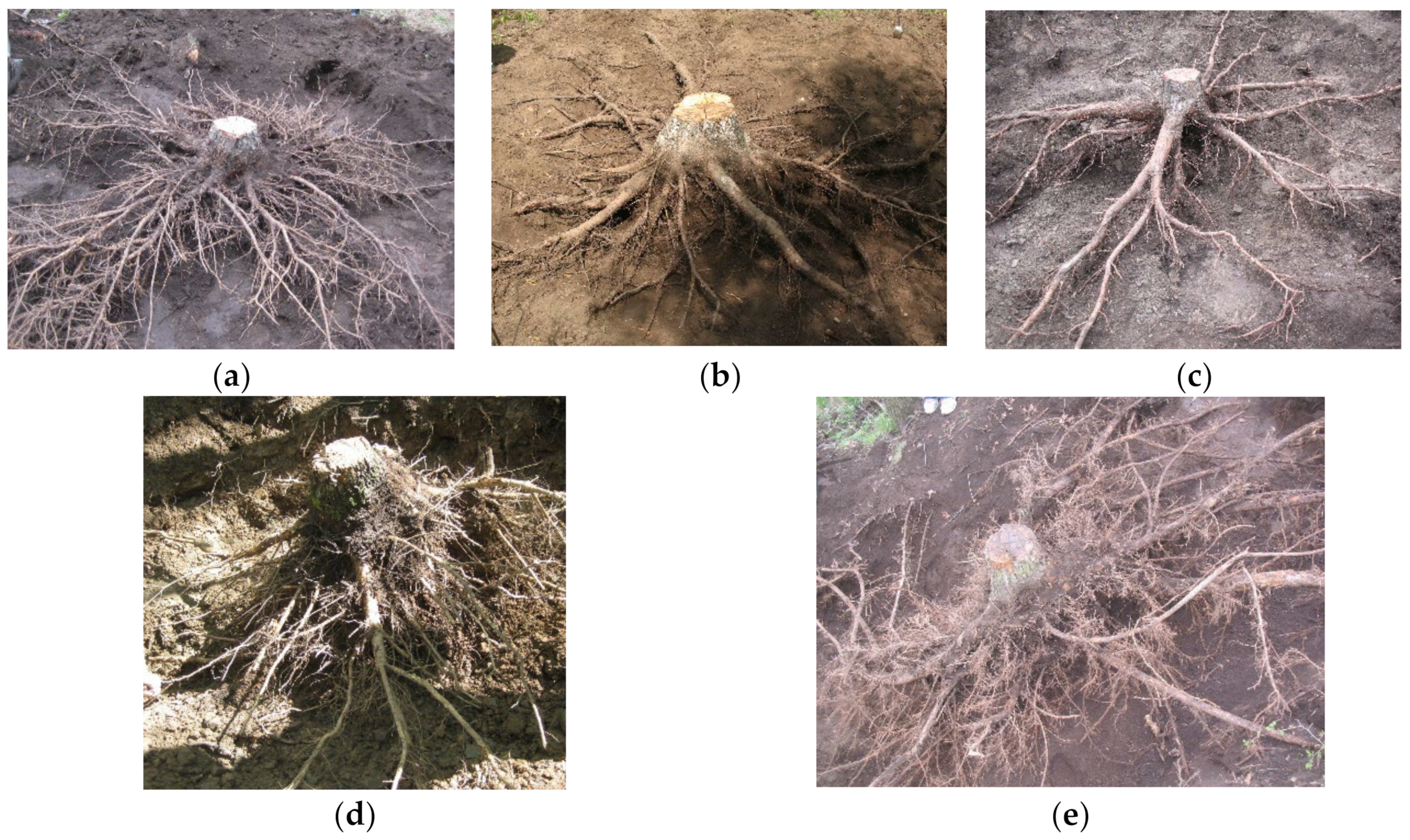

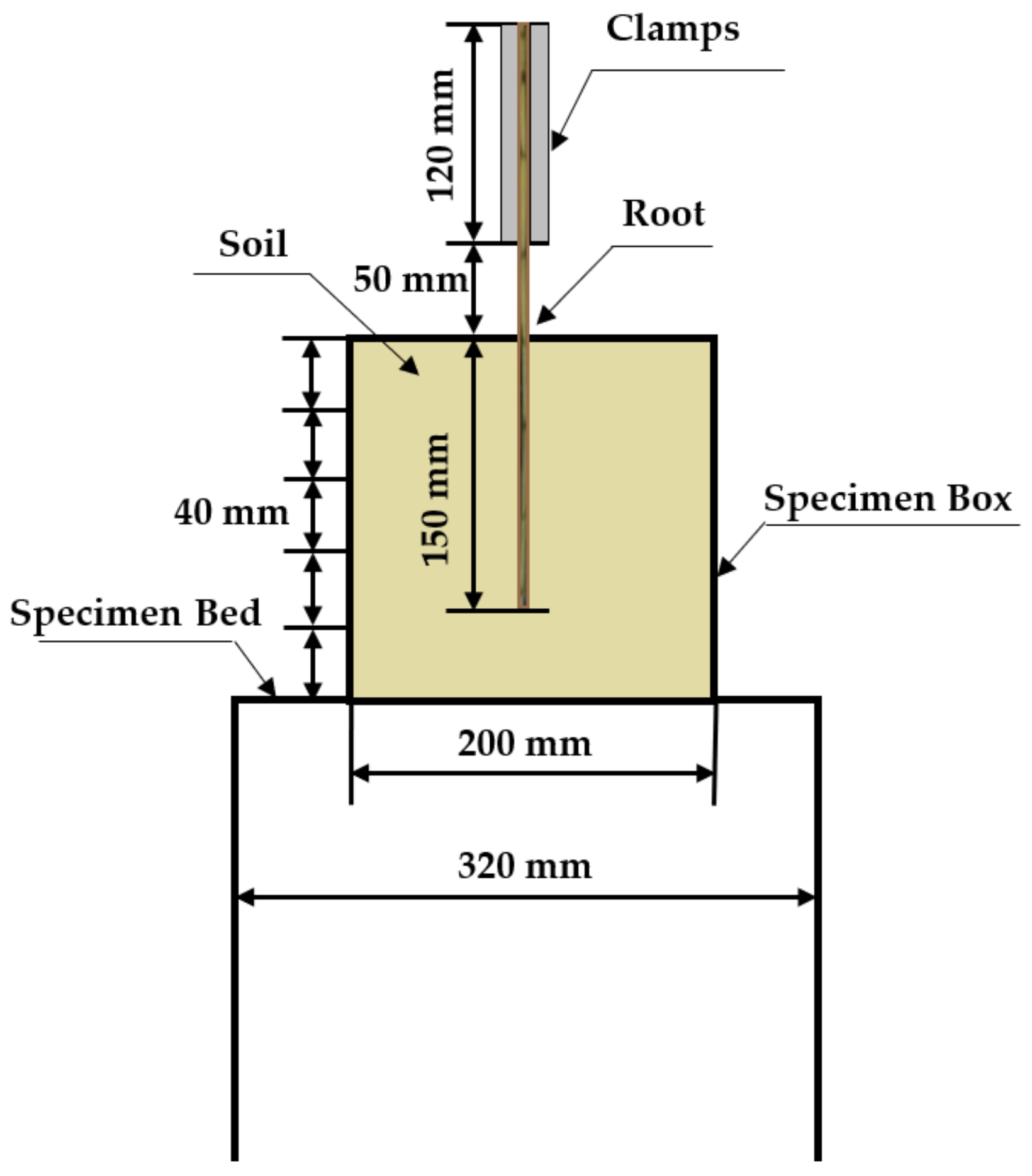
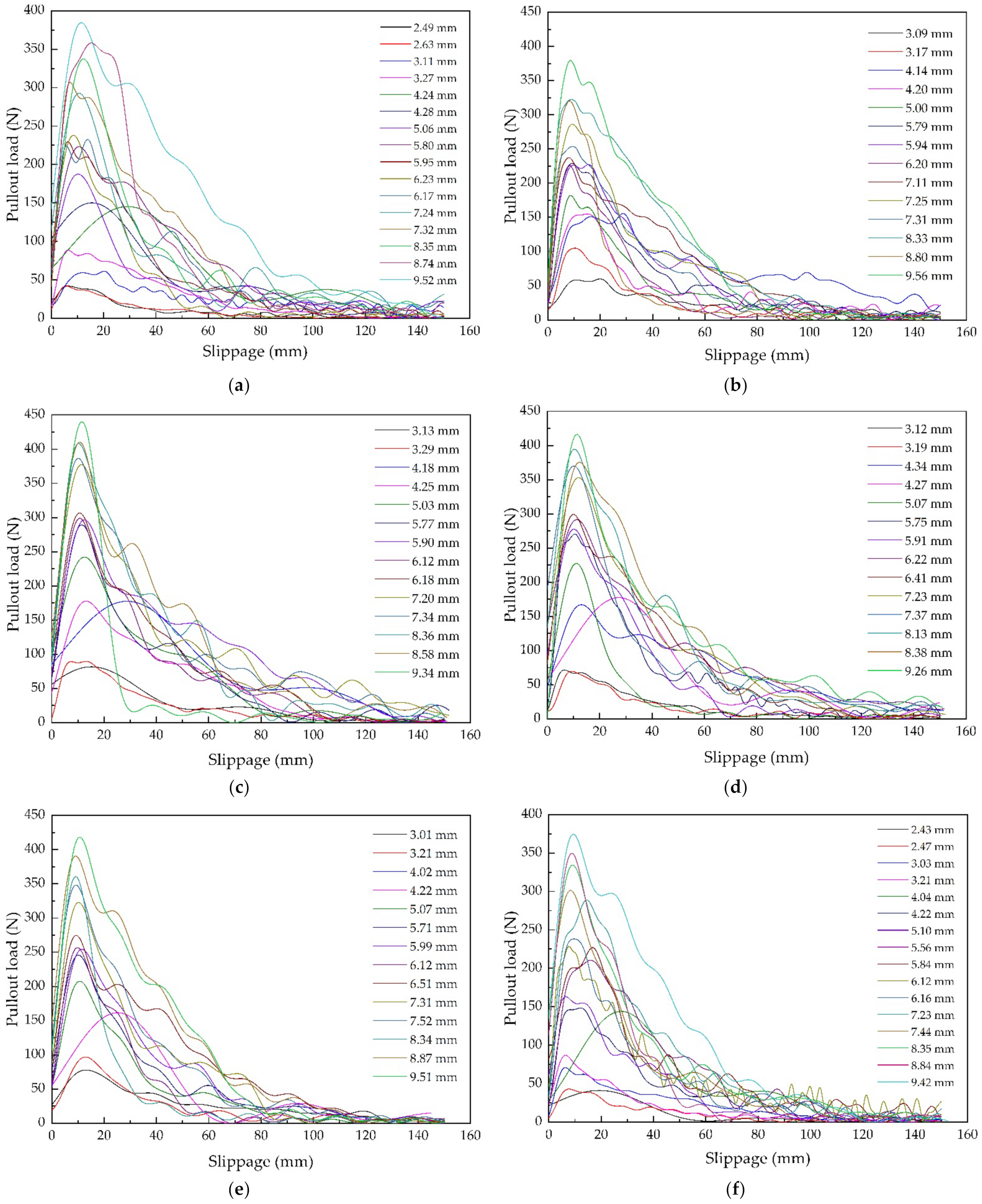




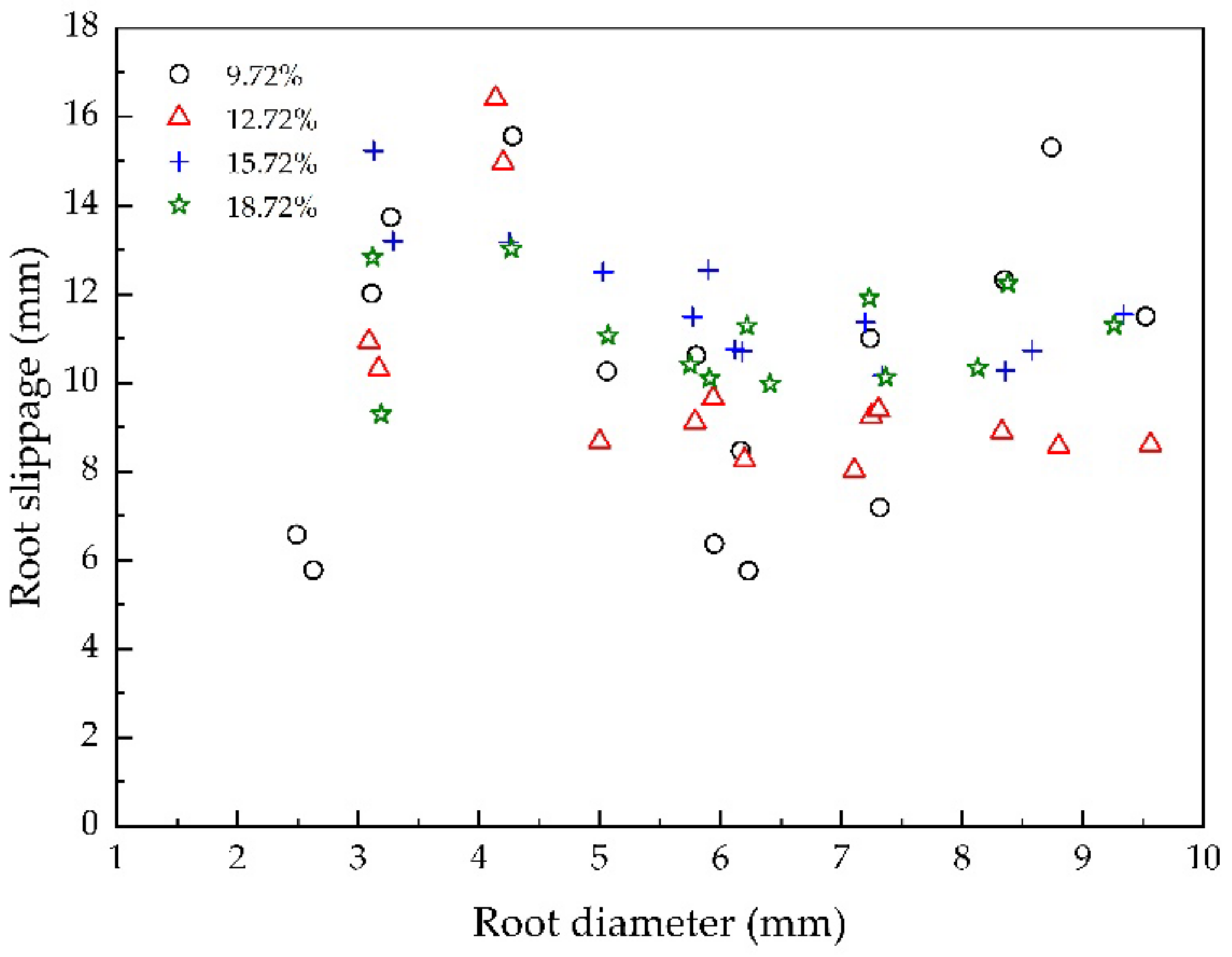
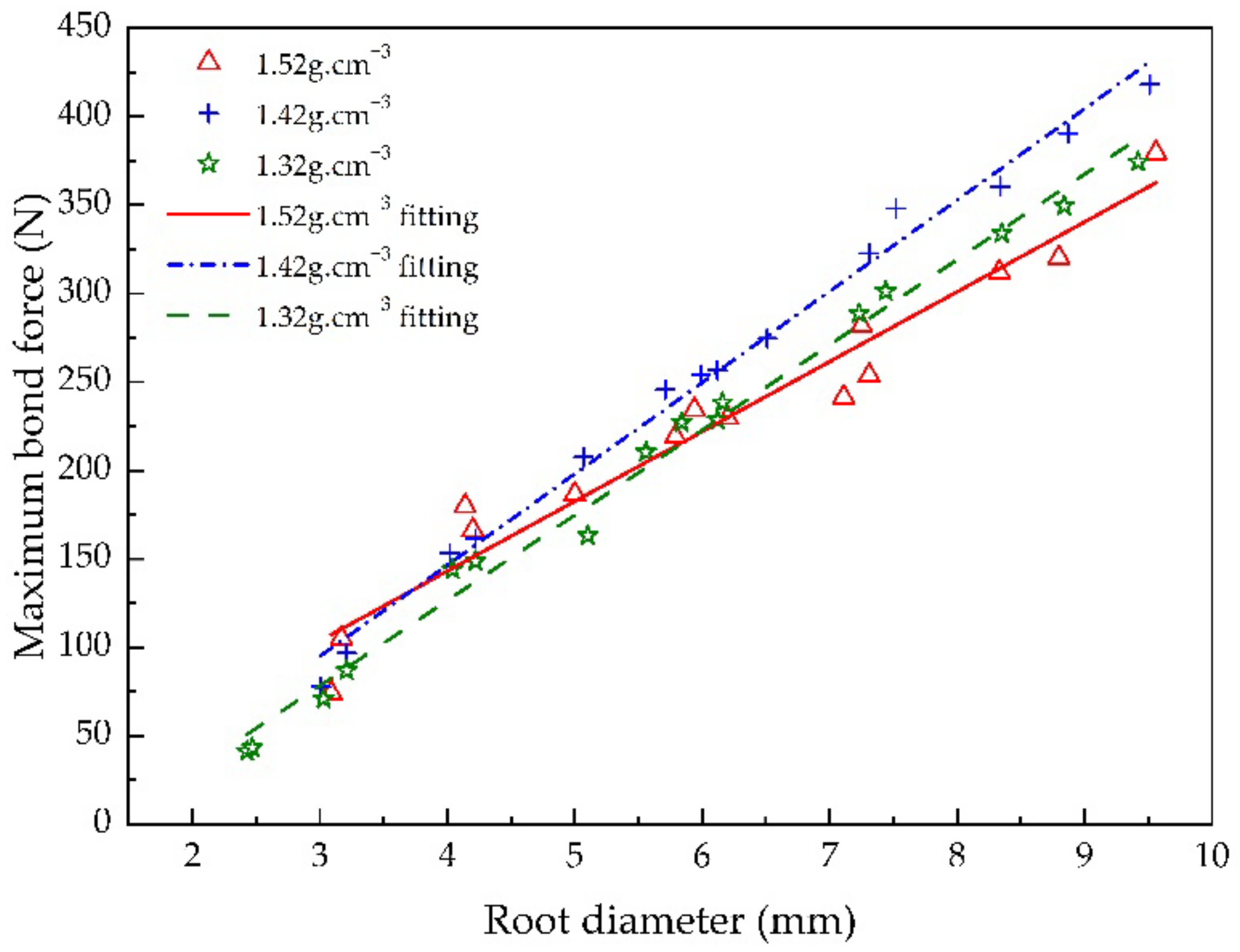


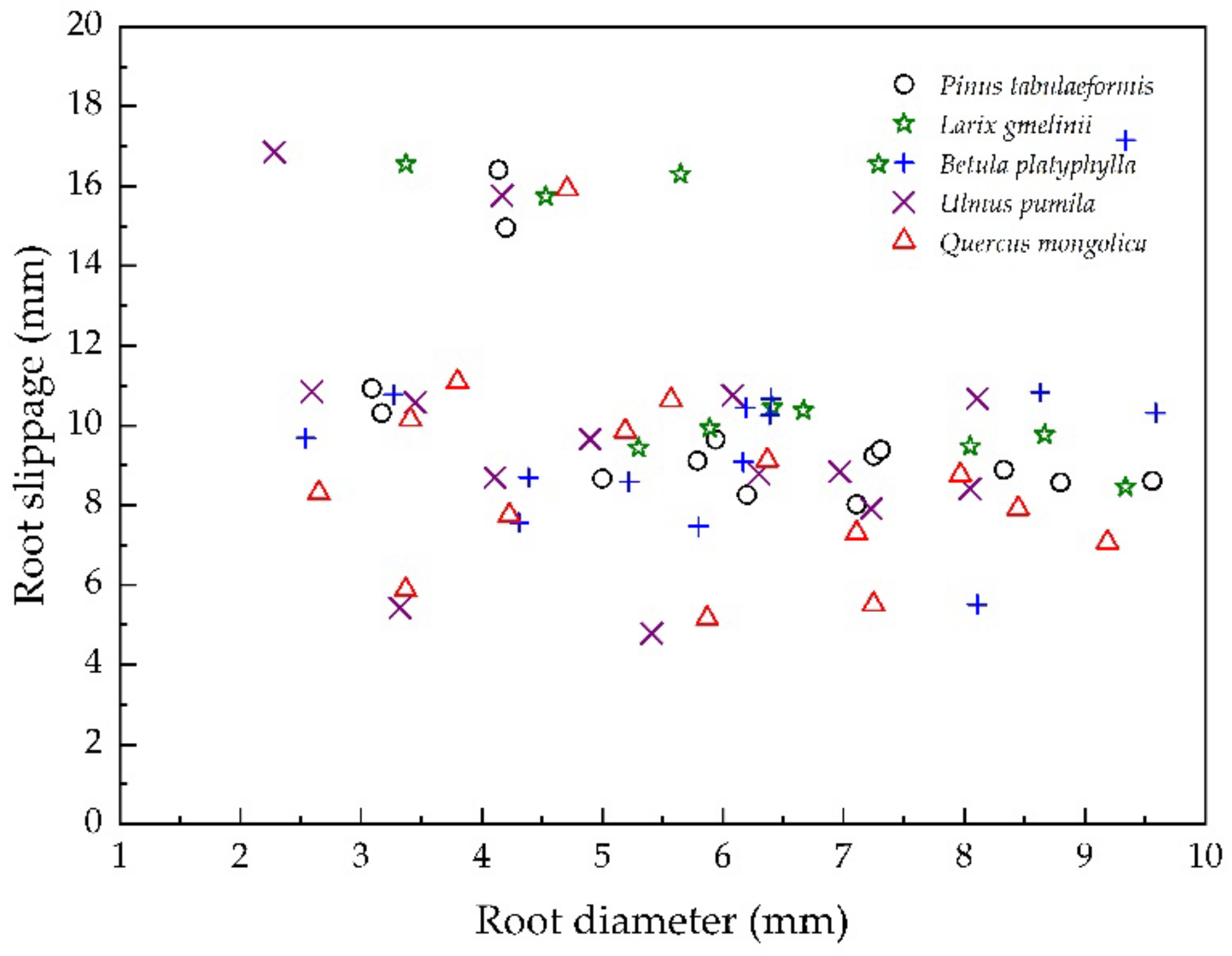
| Tsrn | Tree Species | Ws (%) | ρs (g/cm3) | Drmax (mm) | Drmin (mm) | Nr | |
|---|---|---|---|---|---|---|---|
| Breakage | Pullout | ||||||
| 1 | Pinus tabulaeformis | 9.72 | 1.52 | 9.52 | 1.41 | 2 | 16 |
| 2 | Pinus tabulaeformis | 12.72 | 1.52 | 9.56 | 1.45 | 4 | 13 |
| 3 | Pinus tabulaeformis | 15.72 | 1.52 | 9.34 | 1.35 | 4 | 14 |
| 4 | Pinus tabulaeformis | 18.72 | 1.52 | 9.26 | 1.43 | 4 | 14 |
| 5 | Pinus tabulaeformis | 12.72 | 1.42 | 9.51 | 1.27 | 4 | 14 |
| 6 | Pinus tabulaeformis | 12.72 | 1.32 | 9.42 | 1.43 | 2 | 16 |
| 7 | Betula platyphylla | 12.72 | 1.52 | 9.59 | 1.47 | 5 | 14 |
| 8 | Larix gmelinii | 12.72 | 1.52 | 9.34 | 1.55 | 8 | 10 |
| 9 | Quercus mongolica | 12.72 | 1.52 | 8.11 | 1.39 | 3 | 13 |
| 10 | Ulmus pumila | 12.72 | 1.52 | 9.19 | 1.69 | 4 | 15 |
| Indicator Items | Dry Weight/g/m3 | Water Content /% | Liquid Limit (%) | Plastic Limit (%) | Soil Grain Size (mm) Distribution (%) | |||
|---|---|---|---|---|---|---|---|---|
| <0.001 mm | 0.001–0.005 mm | 0.005–0.01 mm | 0.01– 0.05 mm | |||||
| / | 1.52 | 12.72 | 24.12 | 9.51 | 6.53 | 3.47 | 4.08 | 36.73 |
| Tree Species | C1 | C2 | C3 | C4 | C5 |
|---|---|---|---|---|---|
| Pinus tabulaeformis | 1784.3 ± 130.4 | 1038 ± 97.5 | 1819 ± 158.1 | 460.7 ± 39.2 | 359.7± 31.1 |
| Betula platyphylla | 1904.0 ± 110.7 | 1982.7 ± 156.8 | 2054.7 ± 186.3 | 667.0 ± 131.6 | 331.0 ± 42.7 |
| Larix gmelinii | 1909.0 ± 27.5 | 1357.0 ± 133.9 | 1645.3 ± 88.0 | 971.0 ± 89.1 | 472.1 ± 44.5 |
| Quercus mongolica | 1859 ± 304.0 | 1033.0 ± 237.1 | 1607.7 ± 137.0 | 603.0 ± 93.4 | 243.7 ± 42.5 |
| Ulmus pumila | 1488.7 ± 115.1 | 1278.7 ± 25.7 | 1442.7 ± 149.2 | 608.7 ± 69.8 | 372.0 ± 59.9 |
| Tree Species | S1 | S2 | S3 | S4 | S5 |
|---|---|---|---|---|---|
| Pinus tabulaeformis | 1448.0 ± 120.2 | 2571.3 ± 85.2 | 848.0 ± 76.2 | 346.0 ± 60.2 | 185 ± 29.1 |
| Betula platyphylla | 2310.7 ± 271.3 | 3263.3 ± 182.2 | 862.0 ± 138.5 | 349.3 ± 88.5 | 155.3 ± 15.9 |
| Larix gmelinii | 2456.3 ± 70.1 | 2752.3 ± 143.8 | 795.3 ± 179.9 | 233.0 ± 55.7 | 168.0 ± 45.7 |
| Quercus mongolica | 1676.3 ± 159.6 | 2527.3 ± 647.2 | 976.3 ± 141.1 | 340.3 ± 51.0 | 188.7 ± 34.0 |
| Ulmus pumila | 1438.0 ± 99.1 | 2264.7 ± 107.9 | 884.3 ± 129.6 | 437.3 ± 85.9 | 196.7 ± 26.3 |
| Tree Species | C1 | C2 | C3 | C4 | C5 |
|---|---|---|---|---|---|
| Pinus tabulaeformis | 30.2 ± 3.9 | 53.8 ± 5.8 | 277.0 ± 12.1 | 273.5 ± 87.4 | 852.1 ± 63.6 |
| Betula platyphylla | 51.2 ± 4.1 | 170.1 ± 23.7 | 419.2 ± 45.1 | 622.7 ± 50.1 | 979.9 ± 122.4 |
| Larix gmelinii | 52.1 ± 10.7 | 116.7 ± 21.2 | 536.4 ± 56.8 | 698.9 ± 55.5 | 2309.2 ± 247.9 |
| Quercus mongolica | 24.5 ± 14.1 | 66.8 ± 5.6 | 300.4 ± 41.4 | 584.7 ± 60.2 | 1385.9 ± 92.6 |
| Ulmus pumila | 29.7 ± 7.4 | 111.4 ± 11.3 | 365.1 ± 15.7 | 501.4 ± 27.1 | 968.4 ± 137.5 |
| Tree Species | D (mm) | Dm (mm) | fm (N) | N | Regression Equation | R2 |
|---|---|---|---|---|---|---|
| Pinus tabulaeformis | 0.5~7.75 | 2.864 ± 1.53 | 118.809 ± 124.4 | 152 | F = 5.312D1.7513 | 0.9627 |
| Betula platyphylla | 0.6~9.57 | 3.203 ± 1.93 | 250.06 ± 326.04 | 250 | F = 19.912D1.881 | 0.9469 |
| Larix gmelinii | 1.86~7.17 | 4.395 ± 1.12 | 181.161 ± 87.27 | 81 | F = 17.753D1.552 | 0.8534 |
| Quercus mongolica | 1.99~6.5 | 3.686 ± 1.07 | 255.807 ± 149.53 | 31 | F = 23.879D1.7638 | 0.9471 |
| Ulmus pumila | 2.5~6.69 | 4.113 ± 1.19 | 250.778 ± 109.11 | 27 | F = 45.694D1.1813 | 0.7327 |
| Ws (%) | Dr (mm) | ρs (g/cm3) | Nr |
|---|---|---|---|
| 9.72 | 1.41 | 1.52 | Broken |
| 1.52 | 1.52 | Broken | |
| 12.72 | 1.45 | 1.52 | Broken |
| 1.47 | 1.52 | Broken | |
| 2.42 | 1.52 | Broken | |
| 2.57 | 1.52 | Broken | |
| 15.72 | 1.35 | 1.52 | Broken |
| 1.57 | 1.52 | Broken | |
| 2.46 | 1.52 | Broken | |
| 2.54 | 1.52 | Broken | |
| 18.72 | 1.43 | 1.52 | Broken |
| 1.50 | 1.52 | Broken | |
| 2.44 | 1.52 | Broken | |
| 2.77 | 1.52 | Broken |
| Dr (mm) | ρs (g/cm3) | Ws (%) | Nr | Pulling Force (N) | Displacement (mm) |
|---|---|---|---|---|---|
| 1.41 | 1.52 | 9.72 | Broken | 26.44 | 6.82 |
| 1.45 | 1.52 | 12.72 | Broken | 28.42 | 6.83 |
| 1.35 | 1.52 | 15.72 | Broken | 31.51 | 7.03 |
| 1.43 | 1.52 | 18.72 | Broken | 30.65 | 10.87 |
| 3.27 | 1.52 | 9.72 | Pullout | 73.91 | 12.83 |
| 3.17 | 1.52 | 12.72 | Pullout | 85.11 | 13.46 |
| 3.25 | 1.52 | 15.72 | Pullout | 89.68 | 13.19 |
| 3.19 | 1.52 | 18.72 | Pullout | 69.78 | 10.93 |
| 5.05 | 1.52 | 9.72 | Pullout | 156.33 | 10.63 |
| 5.00 | 1.52 | 12.72 | Pullout | 181.78 | 11.27 |
| 5.03 | 1.52 | 15.72 | Pullout | 242.12 | 12.50 |
| 5.07 | 1.52 | 18.72 | Pullout | 227.40 | 11.06 |
| 7.24 | 1.52 | 9.72 | Pullout | 243.96 | 10.00 |
| 7.25 | 1.52 | 12.72 | Pullout | 283.37 | 10.87 |
| 7.20 | 1.52 | 15.72 | Pullout | 377.34 | 11.63 |
| 7.23 | 1.52 | 18.72 | Pullout | 352.90 | 11.91 |
| Dr (mm) | Ws (%) | ρs (g/cm3) | Nr | Pulling Force (N) | Displacement (mm) |
|---|---|---|---|---|---|
| 1.45 | 12.72 | 1.52 | Broken | 28.42 | 6.83 |
| 1.39 | 12.72 | 1.42 | Broken | 26.91 | 6.42 |
| 1.43 | 12.72 | 1.32 | Broken | 27.36 | 6.41 |
| 3.17 | 12.72 | 1.52 | Pullout | 85.11 | 13.46 |
| 3.21 | 12.72 | 1.42 | Pullout | 80.60 | 12.87 |
| 3.21 | 12.72 | 1.32 | Pullout | 72.43 | 12.11 |
| 5.00 | 12.72 | 1.52 | Pullout | 181.78 | 11.27 |
| 5.07 | 12.72 | 1.42 | Pullout | 172.95 | 10.70 |
| 5.10 | 12.72 | 1.32 | Pullout | 154.15 | 10.41 |
| 7.25 | 12.72 | 1.52 | Pullout | 283.37 | 10.87 |
| 7.31 | 12.72 | 1.42 | Pullout | 269.02 | 10.23 |
| 7.23 | 12.72 | 1.32 | Pullout | 240.68 | 9.87 |
Publisher’s Note: MDPI stays neutral with regard to jurisdictional claims in published maps and institutional affiliations. |
© 2022 by the authors. Licensee MDPI, Basel, Switzerland. This article is an open access article distributed under the terms and conditions of the Creative Commons Attribution (CC BY) license (https://creativecommons.org/licenses/by/4.0/).
Share and Cite
Liu, S.; Ji, X.; Zhang, X. Effects of Soil Properties and Tree Species on Root–Soil Anchorage Characteristics. Sustainability 2022, 14, 7770. https://doi.org/10.3390/su14137770
Liu S, Ji X, Zhang X. Effects of Soil Properties and Tree Species on Root–Soil Anchorage Characteristics. Sustainability. 2022; 14(13):7770. https://doi.org/10.3390/su14137770
Chicago/Turabian StyleLiu, Shusen, Xiaodong Ji, and Xiao Zhang. 2022. "Effects of Soil Properties and Tree Species on Root–Soil Anchorage Characteristics" Sustainability 14, no. 13: 7770. https://doi.org/10.3390/su14137770
APA StyleLiu, S., Ji, X., & Zhang, X. (2022). Effects of Soil Properties and Tree Species on Root–Soil Anchorage Characteristics. Sustainability, 14(13), 7770. https://doi.org/10.3390/su14137770







